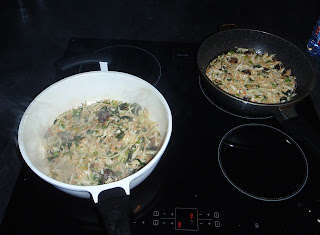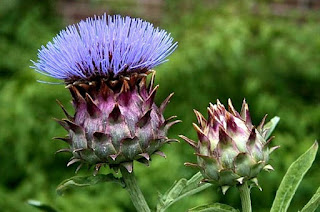Today was a good day. Our Earth's amazing fruits have been offered to me for my intense discovery and enjoyment.
Long Chinese eggplants, also called finger eggplants found their way to my desk this morning along with a few jars of homemade jam. Those eggplants have the word "finger" in them and they are purple!! 'Nuff said.
I also discovered some chiles from the Kabyle area of Algeria offered by a neighbor. This dinner was the perfect combination of the gifts of life (minus the jam.. because it just wasn't going to happen for dinner).
I also discovered some chiles from the Kabyle area of Algeria offered by a neighbor. This dinner was the perfect combination of the gifts of life (minus the jam.. because it just wasn't going to happen for dinner).
Serves 3-4
Ingredients
3-4 long Chinese eggplants (finger eggplants), quartered lengthwise and cut into pieces
1 Tbsp oil (I used coconut)
Japchae:
2 Tbsp oil
1 onion, sliced into moons
2 carrots, grated
1 cup cabbage, shredded
1/2 cup sliced leeks
2 eggs
1 green chile (mine was from Kabyle)
250g Dangmyeon noodles (Korean sweet potato starch noodles), cooked and piping hot
Sauce:
1 tsp doubanjiang paste (Pixian broadbean chile paste)
2 Tbsp light soy sauce
2 Tbsp black vinegar
4 garlic cloves, grated
1 inch piece ginger, grated
Garnish:
few drops sesame oil
chopped green onions
sesame seeds
crushed peanuts
Directions
1. Start with the eggplants. Heat the oil in a wok or heavy based pan and cook the eggplant slices in one layer for about 3 minutes, then flip and cook until all sides are colored and they are bite tender. Remove and set aside.
2. Make your sauce by stirring all the ingredients together.
3. Heat 1 Tbsp oil in the wok and cook the onions until translucent. Push them to the sides of the wok and add the carrots and leeks in the center. Stir fry for about a minute, then push to the sides and add the cabbage and green chile. Stir fry for about 2 minutes, then push to the sides.
4. Add the last Tbsp of oil in the center of the wok. Crack the eggs and let them set a bit. Stir to break them, then stir fry everything, adding half the sauce.
5. Add the cooked hot noodles and the eggplants along with the rest of the sauce and heat through.
6. Serve with desired garnishes
Anything mixing Korean style cooking, Chinese vegetables and Algerian chiles can only be a win win situation. This was a slice of heaven on a cold day..
6. Serve with desired garnishes
Anything mixing Korean style cooking, Chinese vegetables and Algerian chiles can only be a win win situation. This was a slice of heaven on a cold day..



















